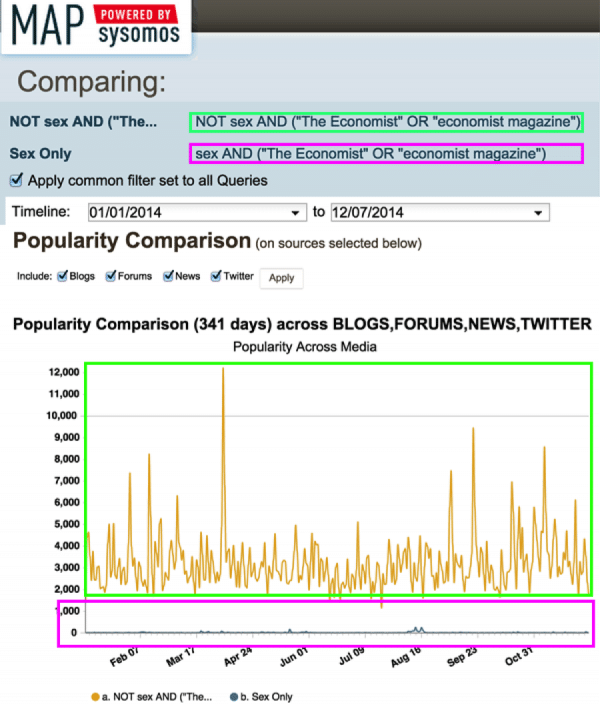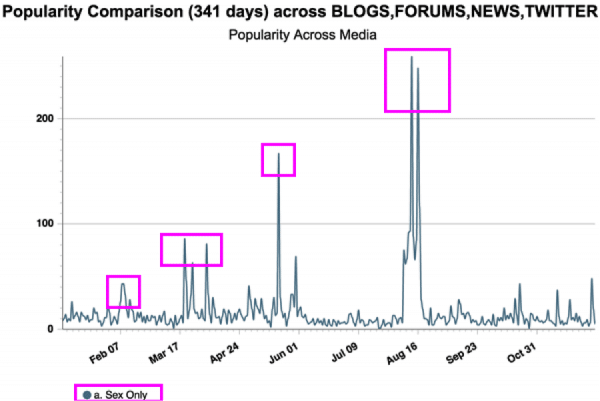Sex sells and The Economist Magazine is taking the world’s oldest profession to a new level of content advertising debauchery to score subscriptions. There’s more to the tactic than meets the eye, especially as concerns The Economists escalation of “Sex” keyword content over the last few years, coupled with a prodigal decline of search interest in The Economist as an entity.
The banner ads below appeared on CNN.com (tablet), Sunday morning. The twin banners on the same page, essentially an above the fold ads takeover of CNN.com, called readers to action asking, “How much does the average man now pay for sex?”
The banners were a subtly lighter variation of CNN’s colors, which arguably made the design look like part of the CNN template while drawing the eye.
The three buttons, which seemingly invited readers to guess the pay-for-sex dollar amount, were actually all part of the single banner leading to a single destination URL. In other words there was no cost-for-sex guessing game, only a possible play for a greater click through per percentage on the overall banner ads.
The landing page in the discover(dot)economist(dot)com subdomain is not indexed in Google, as a result of a robots.text stipulation, common for online advertising landing pages. The objective seemed to be site visitor conversion to subscriptions. Marketers call these “Bait buttons.”
Continued scrolling triggered the following overlay, ratcheting up the subscription sales pitch.
Later on in the content, the Economist’s conversion optimization team really turned the screws to convert new subscribers by introducing yet another “Buy” call-to-action on the right sidebar.
AIMCLEAR has been evangelizing psychographic content amplification as the new display. The perverse intelligence of the Economist’s sexual content advertising play is more than meets the eye. While the targeting may be a little limp, the tactics are modern and enlightened.
An internal search for the article’s headline reveals The Economist is actually pimping old content. The original article appeared last August. Regurgitating 3-month-old sex-themed content to sell subscriptions may reflect poorly on The Economist journalistically. That’s up to the Economist’s publisher to determine.
That said, the tactic is understandable given The Economist’s prodigal decline in search interest since its US search interest peak in 2009. Compare its decline to The Atlantic.
Technical marketing geeks may enjoy noting we filtered the Google Trends queries by applying negative keywords, which resulted in the above graph on 12/7/2014.
> For “The Economist” and “Economist Magazine” we filtered out keywords containing: “Financial”
> For “The Atlantic” and “Atlantic Magazine” we filtered out keywords containing: “Harpers,” “Across the Atlantic” and “Atlantic City”
The Economist has been ramping up its Keyword: “Sex” themed coverage over the last three years. In 2012, there were approximately 3 “Sex” keyword articles online, not including the “Sex” category page. Now it’s 2014 and the tactic has been multiplied about ten times.
(32) 2014, Economist Sex Themed Stories
(14) 2013, Economist Sex Themed Stories
(3) 2012, Economist Sex Themed Stories
In terms of how The Economist’s commitment to “Sex” keyword themed content succeeded, “Sex” social media sexual buzz associated with The Economist does not comprise a very large part of the overall footprint.
The graph below built using Sysomos Heartbeat, Marketwire’s forensic buzz research tool, illustrates how little sexual content comprises The Economist’s overall social chatter. It’s easy to see that “Sex” keyword themed content does not make up a high percentage of buzz that happens about The Economist.
That said, to expand and examine the Economist’s sexual themed content footprint on it’s own, undresses the tactic a bit. There have been a series of transient peaks surrounding “Sex” keyword themed content throughout the year.
Marketers may have simply chosen the August article that got the biggest rise from readers and trotted that content out again to sell with. “Sex” keyword themed content may well result in subscribers.
Sysomos MAP data also indicates that in August the majority of social buzz surrounding this article came from men, which is no surprise. Marketers have been using sex themed content to convert men to customers since the dawn of advertising.
We’re a little surprised that CNN would allow its homepage to be taken over with such content, especially since the banners had faux buttons, masquerading as a game or quiz. Is this really what journalism has come to? Is prostitution a necessary evil to maintain relevancy (or simply existence) today?

















